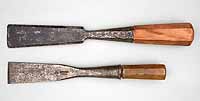Page content
Chisels and Gouges
Corner chisels and wheelers' bruzzes had blades made in the shape of a "V" to cut the corners of larger mortises.

Socket chisels and gouges were designed for heavier work. Their handles fit into hollow sockets, making them stronger than tanged chisels and gouges.
Chisels used for thousands of years
Chisels and gouges are among the most ancient tools used to shape wood, and their basic forms have remained the same for thousands of years. Chisels and gouges shape parts and cut joints more precisely than axes or adzes, and they made cuts that were impractical or impossible to make with saws, planes, spoke shaves, or drawknives during colonial times.
Bench chisels were used for relatively light, general-purpose work, such as paring away small amounts of wood or cutting out dovetails. Their handles were mounted on a pin, or tang, that projected from the rear of the blade.
Gouges used for hollow cuts
Gouges had blades shaped to make hollow cuts. Those sharpened on the outside of the blade were used to make scooped cuts. Gouges sharpened on the inside of the blade were used to cut shapes that matched the curvature of their blades.
Despite their apparent simplicity, woodworkers needed chisels and gouges in a variety of sizes and shapes, each suited to particular job. Toolmakers in the 18th century accommodated these needs by producing a wide range of types for paring wood to size, shaping joints, cutting decorative designs, and shaping wood as it turned on a lathe.


